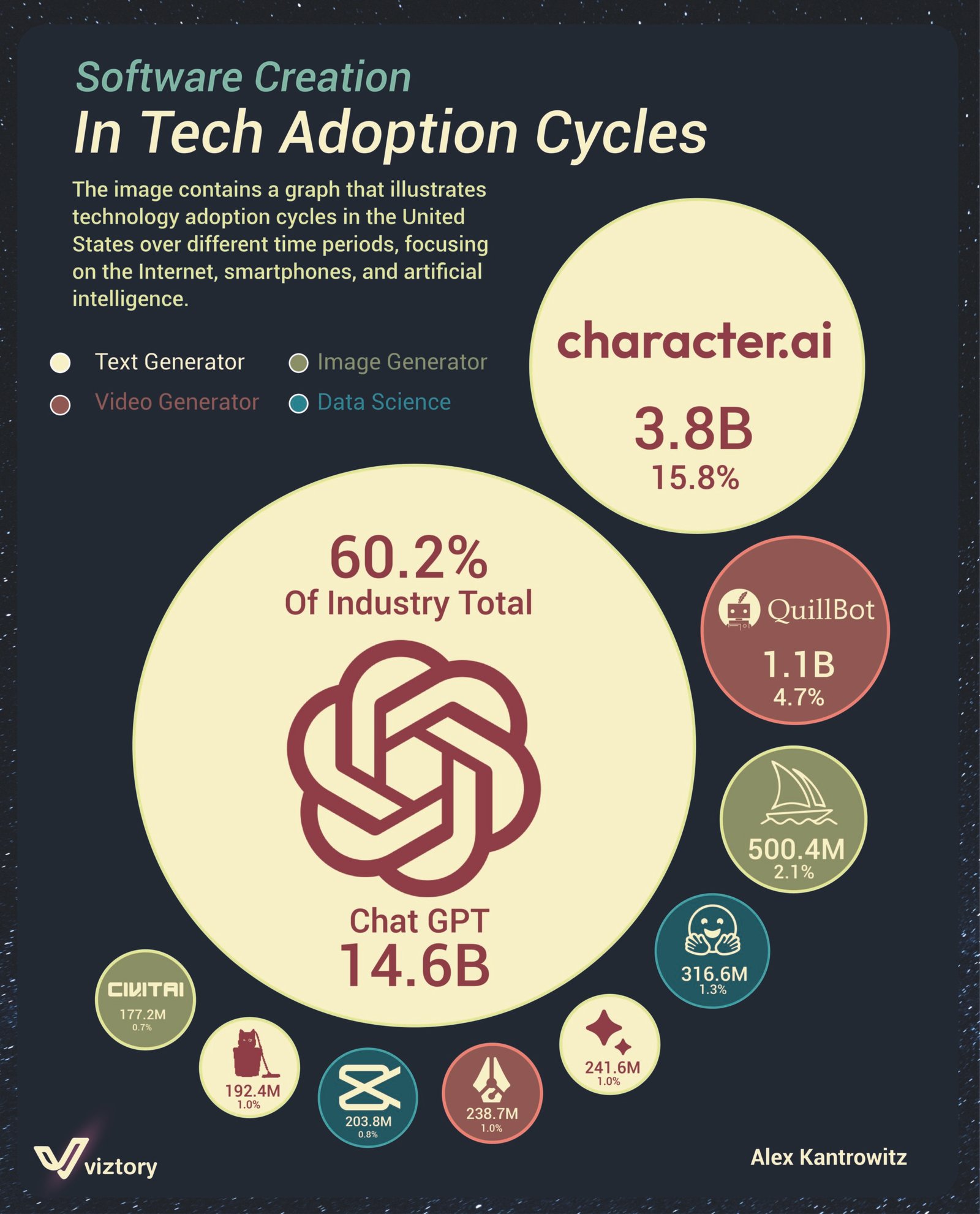Technology Adoption Cycles in Software Creation: A Deep Dive
-
Aug, Thu, 2024
Technology Adoption Cycles in Software Creation: A Deep Dive
The tech industry is in a constant state of flux, with new innovations and tools continuously emerging to reshape how businesses and individuals operate. The infographic you’ve provided offers a snapshot of technology adoption cycles in the United States, particularly focusing on the software creation industry. It highlights the dominance of artificial intelligence (AI) tools like ChatGPT in text generation and showcases other significant players in various categories like image generation, video generation, and data science.
The Dominance of AI in Text Generation
The most striking feature of the infographic is the overwhelming presence of ChatGPT, which holds 60.2% of the industry’s total with 14.6 billion users. This dominance underscores the significant role AI-driven text generators are playing in today’s tech landscape. ChatGPT’s capabilities in natural language processing (NLP) and its widespread adoption across industries—from customer service to content creation—reflect how essential AI has become in automating and enhancing human communication.
Other Significant AI Players
Character.ai is another major player, capturing 15.8% of the market with 3.8 billion users. This tool is particularly known for its ability to generate lifelike digital personas, making it a popular choice for applications that require human-like interaction, such as virtual assistants and gaming.
QuillBot, holding 4.7% of the market share with 1.1 billion users, specializes in paraphrasing and writing enhancement, catering primarily to students, writers, and professionals seeking to improve their written communication.
Emerging Tools in the AI Ecosystem
While text generation is a major focus, the infographic also highlights emerging tools across other categories:
Image Generators: Tools like Civitai and Leonardo.ai, though capturing smaller market shares, are pivotal in the AI-driven art and design industries. These platforms allow users to create images from text prompts, revolutionizing fields like graphic design, marketing, and entertainment.
Video Generators: The ability to create videos using AI is another growing area, with platforms like Runway AI making strides in this domain. AI-generated videos are increasingly being used for content creation, advertising, and even film production.
Data Science Tools: AI’s impact extends to data science as well. Tools like Kaggle have become indispensable for data scientists and analysts, providing platforms to explore and analyze massive datasets, fostering innovation in machine learning and predictive analytics.
The Technological Implications
The widespread adoption of AI in software creation reflects broader technological trends:
Automation: AI tools are increasingly automating tasks that once required significant human effort. This shift is not only improving efficiency but also enabling the creation of content at an unprecedented scale.
Personalization: As AI becomes more integrated into software creation, the ability to deliver personalized content and experiences is becoming more refined. Tools like ChatGPT can tailor responses to individual users, enhancing engagement and satisfaction.
Democratization of Technology: AI tools are making sophisticated technology accessible to a broader audience. Even individuals with minimal technical expertise can leverage AI for tasks like writing, designing, and data analysis, leveling the playing field in various industries.
Ethical Considerations: The growing influence of AI in content creation also raises important ethical questions. Issues around data privacy, the potential for AI-generated misinformation, and the impact on jobs are areas that need careful consideration as these technologies continue to evolve.
Conclusion
The tech adoption cycles depicted in the infographic illustrate the rapid pace at which AI and related technologies are being integrated into the software creation industry. With tools like ChatGPT leading the charge, the future of content creation, communication, and data analysis is poised for continued transformation. As AI continues to advance, it will undoubtedly play an even more significant role in shaping how technology is developed and utilized across all sectors.

